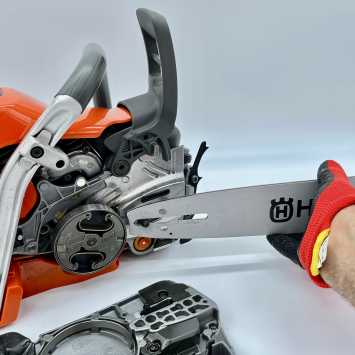Chain specifications and identification
When it’s time to order a new chain, the most common scenario we see is clients taking the whole saw to a supplier and asking for a chain that fits. There’s nothing wrong with this approach, but perhaps a little knowledge may help in widening the range of options to buy remotely or to specify the desired cutter profile or safety features.
Chain specifications become critical, as we will see shortly in the sharpening process.
Chainsaws come in a range of sizes, from the larger heavy-duty version seen on mechanical harvesters, down to the delicate smaller ones on battery-powered pruning saws. Chain size is expressed using chain pitch and chain gauge. The length is specified as the number of drive links.
Chain pitch is the distance between any three rivets measured on the chain when new, divided by two. It is commonly expressed in imperial units (inches) as a fraction or confusingly as a decimal number. It’s normal to use this mash-up of using fractions and decimals in describing a chain in ordering and in selecting the correct filing equipment for maintenance. Stihl also provides the chain pitch data in mm.
This can all seem confusing; however, the chain will be marked indicating its pitch so measurements and calculations are not normally required. For City & Guilds assessments, it is enough to know what pitch is and which one your chain is. Stihl makes a handy, multipurpose measuring tool, which can be placed on a chain. The cutter spacing will only match one of the four patterns exactly, which will indicate the pitch. If you are on one of our courses, we will show different-sized chains and the Oregon chain shadow on the workbench. This allows a rapid and accurate count of the number of drive links, where we are making up a chain from a reel to suit a particular-sized guide bar.
Common chain pitches are as follows:
¼ or 6.35mm
0.325 or 8.25
3/8 or 9.32mm
0.404 or 10.26mm
Chain gauge is the thickness of the drive link, expressed in mm and inches. Common sizes are as follows:
1.1mm (0.043”)
1.3mm (0.050”)
1.5mm (0.058”)
1.6mm (0.063”)
The length of a chain is expressed as the number of drive links.
Most guide bars have their compatible chain specification printed or etched near the bar tail. However, this can become worn or illegible and, of course, it may still need to be referenced to match the drive sprocket pitch, if two options are available for that engine unit.
Because of chain stretch, the chain will become longer over time in use. For this reason, the drive link number is a more reliable measure. Fitting a new chain will require the guide bar to be adjusted back to the minimum tension position, especially where an external clutch assembly needs to be negotiated.
Two left-hand or right-hand cutters may be adjacent because of the impact of an odd number in the drive link specification. This can be a handy starting/ finishing reference point when sharpening.
Cutter profile is the shape and height of the cutter and is best understood by a combination of looking at the chain, using different cutters in the same material and understanding the manufacturer's chain codes or description.
Carefully feeling the transition from the top to the side plate is also a good way to confirm the difference - the semi-chisel has a smooth transition, whilst the full chisel is crisp discernible edge.
- Full chisel
- Micro chisel
Full chisel will give the fastest cut but a higher level of kickback potential will accompany this. Full chisel chains can also be easily damaged by dirty or sandy wood and require greater skill to sharpen accurately.
Semi-chisel chains, on the other hand, are more robust and easier to sharpen. They offer a reasonable cutting performance, with less kickback potential.


